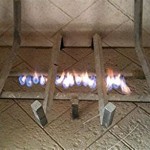Faux Stone Fireplace Installation: A Comprehensive Guide
A fireplace is the centerpiece of many living rooms, adding warmth, ambiance, and a touch of elegance to a home. However, installing a traditional fireplace can be a costly and time-consuming endeavor. For homeowners seeking the aesthetic appeal of a fireplace without the complexities and expense of a real one, faux stone fireplaces offer a practical and stylish alternative. This article provides a comprehensive guide to faux stone fireplace installation, outlining the necessary steps, materials, and considerations to ensure a successful project.
Choosing the Right Faux Stone
The first step in installing a faux stone fireplace is selecting the right type of stone. Faux stone comes in a wide variety of materials, colors, and textures, allowing homeowners to achieve the desired aesthetic for their space. Here are a few popular choices:
- Polyurethane: This lightweight and foam-like material is easy to work with and can be painted to achieve a wide range of colors.
- Fiberglass: Durable and weather-resistant, fiberglass is an excellent option for outdoor fireplaces.
- PVC: Often used for indoor fireplaces, PVC is a cost-effective material with a realistic stone appearance.
- Stone Veneer: Thin slices of real stone that are adhered to a backing material, providing a more authentic look than other options.
When choosing faux stone, it is crucial to consider factors such as the desired style, the size of the fireplace, and the location of the installation. For example, if the fireplace will be exposed to harsh weather conditions, fiberglass or PVC might be a better choice than polyurethane. Visiting a local home improvement store or browsing online retailers can provide inspiration and help homeowners compare different options before making a decision.
Preparing the Installation Area
Before installing the faux stone, it's important to properly prepare the installation area. This involves ensuring a level and stable surface for mounting the fireplace. Here are the key steps:
- Clear the Area: Remove any obstructions or furniture from the installation area to provide ample working space.
- Clean the Surface: Remove dust, debris, and any loose material from the wall or surface where the fireplace will be installed.
- Measure and Mark: Determine the desired location of the fireplace and carefully mark the wall using a level and pencil.
- Install Framing: If necessary, construct a wooden frame using studs or plywood to create a sturdy base for the fireplace.
Taking the time to carefully prepare the installation area ensures that the fireplace is securely mounted and remains level for years to come. By following these steps, homeowners can create a solid foundation for a beautiful and lasting faux stone fireplace.
Installing the Faux Stone
Once the installation area is prepared, the next step is to install the faux stone. This process involves adhering the stone panels to the framing or wall using construction adhesive and fasteners. Here are the general steps:
- Apply Adhesive: Using a construction adhesive specifically designed for faux stone, apply a generous bead along the back of each panel.
- Position Panels: Carefully align the panels according to the desired layout and press firmly against the wall or framing.
- Secure Panels: Use appropriate fasteners such as screws or nails to secure the panels in place.
- Fill Gaps: After all the stone panels are installed, use a mortar or grout to fill any gaps or seams between the stones.
- Finish and Seal: Once the mortar or grout has dried, apply sealant to protect the faux stone from moisture and dirt, ensuring a durable and long-lasting finish.
It is important to follow the manufacturer's instructions for installing the specific type of faux stone chosen. Some manufacturers may recommend using a different adhesive or fasteners for their products. Carefully reading and understanding the instructions will prevent any installation errors and result in a beautiful and well-installed faux stone fireplace.
Additional Considerations for Installation
In addition to the basic steps outlined above, several other factors warrant consideration when installing a faux stone fireplace.
- Fireplace Insert: If desired, a fireplace insert can be installed to provide realistic fire effects. These come in various styles, including electric, gas, or pellet inserts, offering flexibility and warmth.
- Mantel: A mantel can be added above the fireplace for decoration and functionality, providing space for decorative pieces or photo frames. The mantel can be made from wood, stone, or other materials that complement the style of the fireplace.
- Lighting: Installing lighting around the fireplace can enhance its aesthetic appeal and create a cozy ambiance. This can be achieved with sconces, recessed lighting, or even string lights.
By considering these additional factors, homeowners can customize their faux stone fireplace to create a personalized and visually stunning focal point in their living space.

Thin Stone Veneers Make A Fireplace Update Easy Swenson Granite 100 Natural Stones

Faux Stone Fireplace Entertainment Center Genstone

How To Install Faux Stone Veneer Lowe S

How To Build A Diy Stone Fireplace Boxwood Design Co

ᑕ❶ᑐ Faux Stone Electric Fireplace Where Does It Match Best

Diy Faux Stone Fireplace Chimney H2obungalow

Faux Stone Panels For Fireplaces

How To Install A Stone Veneer Fireplace Shoe Makes New

Stone Fireplace Design And Remodel

Diy Faux Stone Fireplace Chimney H2obungalow
Related Posts








